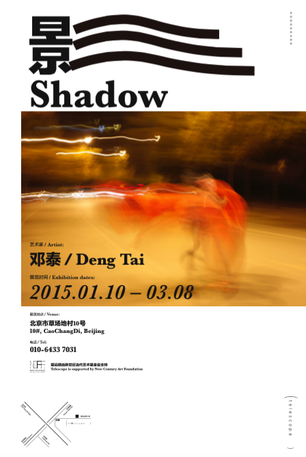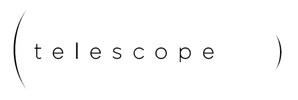
Deng Tai
“Shadow” JAN. 10, 2015 – MAR. 8, 2015
Deng Tai’s second solo exhibition at Telescope focuses on two specific nighttime performances entitled Shadow and Walking.
Shadow takes us on a dream like journey to vaguely familiar places in the city’s ever-present twilight. Out of focus images in hazy landscapes whirr by, occasionally resting long enough for us to make out a ghostly figure with a white pasted face draped in a flowing river of red satin. The figure is strangely familiar but alien and untouchable, like a shadow on a wall. Deng treats Beijing City like a stage for a new Chinese Opera, incorporating ancient tropes of costumes and make up but reducing them to their most simple and elemental forms; the long flowing “water” sleeves of the elaborate Peking Opera actors gowns, which are used to express emotions, have become Deng’s entire costume, the painted face that depicts the identity or emotions of a character is now just a mute yet haunting pancake white mask with thick black eyebrows and red circles for cheeks and lips.
Much of Deng’s work seems to emphasize his outsiders’ role socially. He was a joyous, sensitive, and loving individual but felt alone in a world that could not see, hear, or accept him like he was or others like him. He felt he had no voice and little hope except on the stage that he built in his creative imagination where through his movements and personal iconography he could tell his story. There is a child’s simplicity and foolishness to his actions, but as children are, his aim is true and his voice is arrestingly honest and moving. In this performance Deng chose the cover of night in which to play. The night is a shroud that protects and hides and gives freedom of movement and expression, a world that is hazy and indistinct, but also provides contrast. Deng’s red material suggests a river of blood flowing out into the world. He carries his vulnerable heart in his arms for all to see. Blood is the power of life within our bodies but, when given, it also has the power of sacrifice for others. This river flows in and around Deng, like a womb, and then is released into the air following him like a hero’s cape or the translucent wings of a bird in flight. His painted face, drawn from a memory of a cartoon character from his childhood, glows like a white lantern peering at us through our bedroom window. His gaze is silent but straightforward and with the innocence, love, and insight of a child he waits our response.
Walking is a series of photos made over a three to four year period of time, in different cities, always at night, using only the street and shop lights for illumination. It is simply the recording of a journey, walking an endless road, without a map, to some distant and undefined destination. The darkness of night obscures the details of place, incandescent and neon lights alter colors and shadows creating a soft and unearthly landscape without a horizon. We often spend our lives not really knowing what we are really doing or where we are going. We walk by faith believing that, step-by-step, life will take us where we need to go, but each step is fraught with struggles and doubts. We feel translucent or alien in a world of substance. We cannot understand the pictures of each individual day or appreciate their intrinsic beauty. They are abstract to us. We focus on the moment and when we look back at our lives, each day is just a whirr of hues and shapes in our memories. Walking is a simple travellers passage down streets, over bridges, up stairs, around corners, past buildings, glass, trees, and lights. Each photo, or each frame, is a painting of a day in the life, but all together it is a bigger story, a journey without beginning and without end.
Photos from Shadow taken by Tony Kwo
Photos and video from Walking by James Elaine
Music for Walking by William Basinski
《影》 2015.01.10 – 03.08
邓泰在望远镜的第二场个展将聚焦于两次特别的夜间行为表演,分别题为《影》和《行》。
《影》将我们带入一场梦幻般的旅程,这旅程通向城市永恒暮光下有着些许熟悉味道的地方。失焦的图像在虚渺的风景中呼呼而过,间或停留足够长的时间,以供我们辨认出一个幽灵般的形象,他面部糊成白色,身披红色缎子构成的流动的河。这形象怪异地令人熟悉,却也陌生、触不可及,仿佛墙上的一具影子。邓泰把北京城当作一个新京剧的舞台,他吸纳了古代寄托于服饰与妆容的寓意,但将其简化为最简单、质朴的形式;京剧演员身着的精巧长袍上用以表达情绪、修长飘逸的“水”袖在邓泰这里成为了其服饰的全部,而用以描绘一个角色身份或情感的妆容在此则只是一张沉默却令人难忘的平展白色面具,眉毛浓黑,脸颊和嘴唇上涂着红点。
邓泰的很多作品似乎都强调着他在社会中的局外人角色。他是一个愉快、敏感、有爱的人,但他却感到孤单,因为他身处的世界无法看见、听见或接受他真正的样子以及其他像他一样的人。他感到,只有在他那富有创造力的想象中搭建的舞台上,他才能发出声音并怀有几缕希望,在那里,他可以藉由自己的行动与个人的标志性形象讲述他的故事。他的行为中有一种孩童式的简单与愚笨,而他也像孩童一般,目的真实,声音诚实动人、引人注意。在这个作品中,邓泰选择在夜幕的掩护下进行表演。夜幕是一层帷帐,它保护、掩蔽并给予了行动和表达的自由,夜晚的世界朦胧难辨,却也形成反差。邓泰的红色布料暗示着一条鲜血流成的河流出身体,流入世界。他将自己脆弱的心捧在怀里,给所有人看。血液是我们身体内部的生命力,但在特定的时候,它也具有为他人奉献的力量。这条河既在邓泰的体内流淌,也在他周围流淌,如同子宫一般,之后则被释放到空气中,仿佛英雄的斗篷或飞行中的鸟晶莹剔透的翅膀那样追随着他。涂白的面孔是根据他对于童年一个卡通人物的记忆画成的,这张面孔像白色灯笼般泛着光,透过我们的卧室窗户凝视着我们。他的凝视静默而直接,而他带着孩童般的天真、爱与领悟力等待着我们的回应。
《行》是一组拍摄于三四年间不同城市的照片,通常拍摄于夜晚,仅以街灯和商店的灯光作为照明。这只是对于一场旅行的记录——在没有尽头的道路上行走,没有地图,走向某个遥远而不明确的目的地。夜的黑暗遮掩了一处地方的细节,白炽灯和霓虹灯变幻着色彩与影子,制造出一片没有边际、柔和而神秘的风景。我们往往穷尽一生却不真正知晓自己在做什么或要向何处去。我们依信念而行,相信生命会一步步将我们带到我们需要去到的地方,然而每一步却在奋力与疑问中挣扎。在实在的世界中,我们或感到透明,或格格不入。我们无法理解每一天的写照,也无法欣赏其内在之美。对我们来说它们是抽象的。我们关注瞬间,而当我们回顾自己的生活时,每个日子也不过是我们记忆中一阵呼呼而过的色彩与形状。《行》是一位单纯旅者的旅程,他走上街道、跨过桥梁、登上台阶、路过转角、穿越楼宇、窗玻璃、树木和灯光。每张照片或每个镜框内都是对于生命中某一天的刻画,但它们放在一起却讲述着一个更大的故事,一场没有起点也没有终点的旅行。
《影》的照片由郭雨乐(Tony Kwo)拍摄
《行》的照片由林杰明(James Elaine)拍摄
《行》的音乐由William Basinski 制作
“Shadow” JAN. 10, 2015 – MAR. 8, 2015
Deng Tai’s second solo exhibition at Telescope focuses on two specific nighttime performances entitled Shadow and Walking.
Shadow takes us on a dream like journey to vaguely familiar places in the city’s ever-present twilight. Out of focus images in hazy landscapes whirr by, occasionally resting long enough for us to make out a ghostly figure with a white pasted face draped in a flowing river of red satin. The figure is strangely familiar but alien and untouchable, like a shadow on a wall. Deng treats Beijing City like a stage for a new Chinese Opera, incorporating ancient tropes of costumes and make up but reducing them to their most simple and elemental forms; the long flowing “water” sleeves of the elaborate Peking Opera actors gowns, which are used to express emotions, have become Deng’s entire costume, the painted face that depicts the identity or emotions of a character is now just a mute yet haunting pancake white mask with thick black eyebrows and red circles for cheeks and lips.
Much of Deng’s work seems to emphasize his outsiders’ role socially. He was a joyous, sensitive, and loving individual but felt alone in a world that could not see, hear, or accept him like he was or others like him. He felt he had no voice and little hope except on the stage that he built in his creative imagination where through his movements and personal iconography he could tell his story. There is a child’s simplicity and foolishness to his actions, but as children are, his aim is true and his voice is arrestingly honest and moving. In this performance Deng chose the cover of night in which to play. The night is a shroud that protects and hides and gives freedom of movement and expression, a world that is hazy and indistinct, but also provides contrast. Deng’s red material suggests a river of blood flowing out into the world. He carries his vulnerable heart in his arms for all to see. Blood is the power of life within our bodies but, when given, it also has the power of sacrifice for others. This river flows in and around Deng, like a womb, and then is released into the air following him like a hero’s cape or the translucent wings of a bird in flight. His painted face, drawn from a memory of a cartoon character from his childhood, glows like a white lantern peering at us through our bedroom window. His gaze is silent but straightforward and with the innocence, love, and insight of a child he waits our response.
Walking is a series of photos made over a three to four year period of time, in different cities, always at night, using only the street and shop lights for illumination. It is simply the recording of a journey, walking an endless road, without a map, to some distant and undefined destination. The darkness of night obscures the details of place, incandescent and neon lights alter colors and shadows creating a soft and unearthly landscape without a horizon. We often spend our lives not really knowing what we are really doing or where we are going. We walk by faith believing that, step-by-step, life will take us where we need to go, but each step is fraught with struggles and doubts. We feel translucent or alien in a world of substance. We cannot understand the pictures of each individual day or appreciate their intrinsic beauty. They are abstract to us. We focus on the moment and when we look back at our lives, each day is just a whirr of hues and shapes in our memories. Walking is a simple travellers passage down streets, over bridges, up stairs, around corners, past buildings, glass, trees, and lights. Each photo, or each frame, is a painting of a day in the life, but all together it is a bigger story, a journey without beginning and without end.
Photos from Shadow taken by Tony Kwo
Photos and video from Walking by James Elaine
Music for Walking by William Basinski
《影》 2015.01.10 – 03.08
邓泰在望远镜的第二场个展将聚焦于两次特别的夜间行为表演,分别题为《影》和《行》。
《影》将我们带入一场梦幻般的旅程,这旅程通向城市永恒暮光下有着些许熟悉味道的地方。失焦的图像在虚渺的风景中呼呼而过,间或停留足够长的时间,以供我们辨认出一个幽灵般的形象,他面部糊成白色,身披红色缎子构成的流动的河。这形象怪异地令人熟悉,却也陌生、触不可及,仿佛墙上的一具影子。邓泰把北京城当作一个新京剧的舞台,他吸纳了古代寄托于服饰与妆容的寓意,但将其简化为最简单、质朴的形式;京剧演员身着的精巧长袍上用以表达情绪、修长飘逸的“水”袖在邓泰这里成为了其服饰的全部,而用以描绘一个角色身份或情感的妆容在此则只是一张沉默却令人难忘的平展白色面具,眉毛浓黑,脸颊和嘴唇上涂着红点。
邓泰的很多作品似乎都强调着他在社会中的局外人角色。他是一个愉快、敏感、有爱的人,但他却感到孤单,因为他身处的世界无法看见、听见或接受他真正的样子以及其他像他一样的人。他感到,只有在他那富有创造力的想象中搭建的舞台上,他才能发出声音并怀有几缕希望,在那里,他可以藉由自己的行动与个人的标志性形象讲述他的故事。他的行为中有一种孩童式的简单与愚笨,而他也像孩童一般,目的真实,声音诚实动人、引人注意。在这个作品中,邓泰选择在夜幕的掩护下进行表演。夜幕是一层帷帐,它保护、掩蔽并给予了行动和表达的自由,夜晚的世界朦胧难辨,却也形成反差。邓泰的红色布料暗示着一条鲜血流成的河流出身体,流入世界。他将自己脆弱的心捧在怀里,给所有人看。血液是我们身体内部的生命力,但在特定的时候,它也具有为他人奉献的力量。这条河既在邓泰的体内流淌,也在他周围流淌,如同子宫一般,之后则被释放到空气中,仿佛英雄的斗篷或飞行中的鸟晶莹剔透的翅膀那样追随着他。涂白的面孔是根据他对于童年一个卡通人物的记忆画成的,这张面孔像白色灯笼般泛着光,透过我们的卧室窗户凝视着我们。他的凝视静默而直接,而他带着孩童般的天真、爱与领悟力等待着我们的回应。
《行》是一组拍摄于三四年间不同城市的照片,通常拍摄于夜晚,仅以街灯和商店的灯光作为照明。这只是对于一场旅行的记录——在没有尽头的道路上行走,没有地图,走向某个遥远而不明确的目的地。夜的黑暗遮掩了一处地方的细节,白炽灯和霓虹灯变幻着色彩与影子,制造出一片没有边际、柔和而神秘的风景。我们往往穷尽一生却不真正知晓自己在做什么或要向何处去。我们依信念而行,相信生命会一步步将我们带到我们需要去到的地方,然而每一步却在奋力与疑问中挣扎。在实在的世界中,我们或感到透明,或格格不入。我们无法理解每一天的写照,也无法欣赏其内在之美。对我们来说它们是抽象的。我们关注瞬间,而当我们回顾自己的生活时,每个日子也不过是我们记忆中一阵呼呼而过的色彩与形状。《行》是一位单纯旅者的旅程,他走上街道、跨过桥梁、登上台阶、路过转角、穿越楼宇、窗玻璃、树木和灯光。每张照片或每个镜框内都是对于生命中某一天的刻画,但它们放在一起却讲述着一个更大的故事,一场没有起点也没有终点的旅行。
《影》的照片由郭雨乐(Tony Kwo)拍摄
《行》的照片由林杰明(James Elaine)拍摄
《行》的音乐由William Basinski 制作
